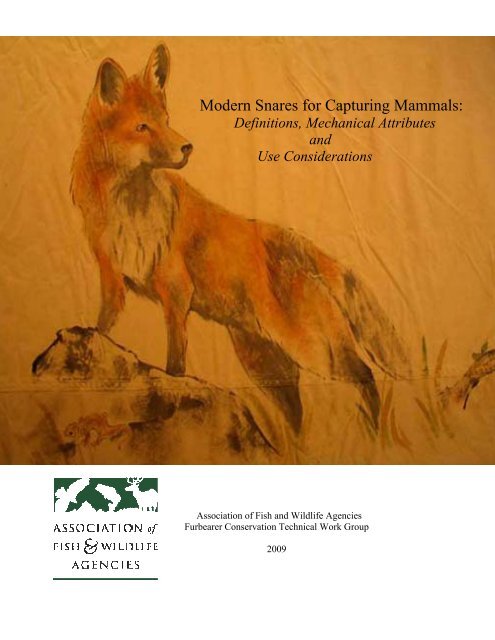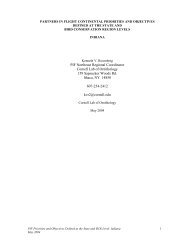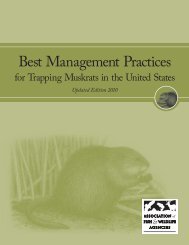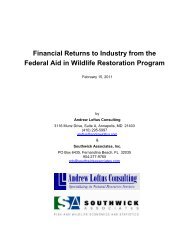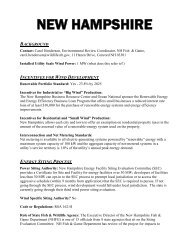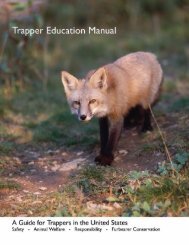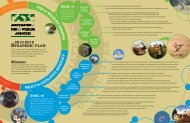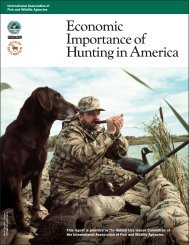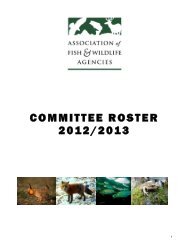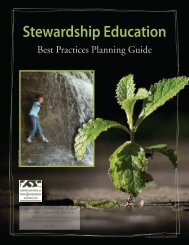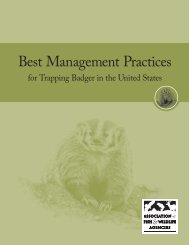Modern Snares for Capturing Mammals: - Association of Fish and ...
Modern Snares for Capturing Mammals: - Association of Fish and ...
Modern Snares for Capturing Mammals: - Association of Fish and ...
- No tags were found...
You also want an ePaper? Increase the reach of your titles
YUMPU automatically turns print PDFs into web optimized ePapers that Google loves.
ACKNOWLEDGMENTSThis document was produced by the <strong>Association</strong> <strong>of</strong> <strong>Fish</strong> <strong>and</strong> Wildlife Agencies (AFWA)Furbearer Conservation Technical Work Group, in consultation with representatives fromtrapping organizations <strong>and</strong> snare manufacturers. The U.S. Department <strong>of</strong> Agriculture (USDA)provided funding <strong>for</strong> trapping BMP research <strong>and</strong> development. We also wish to acknowledgethe contributions <strong>of</strong> numerous state fish <strong>and</strong> wildlife agency personnel. We especiallyacknowledge Dr. John Erb <strong>of</strong> the Minnesota Department <strong>of</strong> Natural Resources, Forest WildlifePopulations <strong>and</strong> Research Group <strong>for</strong> serving as primary author on this document. Weacknowledge Alan Huot <strong>for</strong> providing numerous photos. Cover illustration used by permission<strong>of</strong> Nomadics Tipi Makers.The <strong>Association</strong> <strong>of</strong> <strong>Fish</strong> <strong>and</strong> Wildlife Agencies was founded in 1902. Itis an organization <strong>of</strong> public agencies charged with the protection <strong>and</strong>management <strong>of</strong> North America’s fish <strong>and</strong> wildlife resources. The 50state fish <strong>and</strong> wildlife agencies, as well as provincial <strong>and</strong> territorialgovernments in Canada are members. Federal fish <strong>and</strong> wildlife <strong>and</strong>natural resource agencies in Canada <strong>and</strong> the United States are alsomembers. The <strong>Association</strong> has been a key organization in promotingsound resource management <strong>and</strong> strengthening state, provincial, federal,<strong>and</strong> private cooperation in protecting <strong>and</strong> managing fish <strong>and</strong> wildlife <strong>and</strong>their habitats in public interest.2Ver. 1.0
TABLE OF CONTENTSINTRODUCTION..... 5SNARE COMPONENTS….. 6Snare Cable….. 6Snare Locks….. 9Breakaway Devices….. 10Loop Stops….. 13Swivels….. 13SNARING SYSTEM COMPONENTS….. 14Snare-Activation….. 14Capture Area….. 15DESCRIBING MODERN SNARES….. 15SNARE PERFORMANCE….. 16Killing versus Live-Restraining Animals….. 16Selectivity….. 19Snare Efficiency….. 21CONCLUSIONS….. 233Ver. 1.0
FORWARD“<strong>Modern</strong> <strong>Snares</strong> <strong>for</strong> <strong>Capturing</strong> <strong>Mammals</strong>” is primarily intended as a reference document <strong>for</strong>resource pr<strong>of</strong>essionals, but may have utility in various educational <strong>for</strong>ums. Our goals are to <strong>of</strong>ferdefinitions <strong>of</strong> snares <strong>and</strong> snare components, describe the various types <strong>of</strong> <strong>and</strong> uses <strong>for</strong> snares, <strong>and</strong>discuss various factors that may influence important snare per<strong>for</strong>mance attributes. While somediscussion focuses on user-controlled variables, this document is NOT intended as a snaring‘How To’ guide, nor does it recommend specific snares or snare components. The appropriatedesign <strong>and</strong> use <strong>for</strong> a snare will vary depending on species, time <strong>and</strong> location, <strong>and</strong> multipledesigns may accomplish the same objective. Furthermore, additional scientific data on snareper<strong>for</strong>mance is necessary be<strong>for</strong>e wide-ranging comparisons <strong>of</strong> different snare designs can bemade. As such, we hope this document stimulates continued research <strong>and</strong> development <strong>of</strong>snaring systems. Depiction <strong>of</strong>, or reference to, specific snares or snare components does notconstitute a recommendation or endorsement by AFWA. This document may be updatedperiodically <strong>and</strong> updates will be posted at the AFWA furbearer website(www.fishwildlife.org/furbearer.html).4Ver. 1.0
<strong>Modern</strong> <strong>Snares</strong> <strong>for</strong> <strong>Capturing</strong> <strong>Mammals</strong>:Definitions, Mechanical Attributes, <strong>and</strong> UseConsiderations…………………………………………………………………………………………………………………………INTRODUCTION<strong>Snares</strong> represent one <strong>of</strong> the oldest devices used <strong>for</strong> capturing animals. Their use dates backthous<strong>and</strong>s <strong>of</strong> years, as evidenced by their depiction in cave drawings. While some snares areconcealed under dirt or snow, snares are most commonly placed along existing animal travelroutes, or along the anticipated path <strong>of</strong> travel an animal may use when approaching bait or otherattractant. They can be, <strong>and</strong> historically were, designed or deployed to capture animals by theneck, torso, leg, or foot. While the basic principles behind snare use have changed little throughtime, the physical <strong>and</strong> mechanical options <strong>for</strong> snare design have greatly exp<strong>and</strong>ed, <strong>and</strong> snaresremain a popular capture device among licensed fur trappers, animal damage controlpr<strong>of</strong>essionals, <strong>and</strong> increasingly among wildlife biologists.Historically, snares were constructed <strong>of</strong> various plant or animal fibers, <strong>and</strong> lacked reliablemechanisms (i.e., locks) that not only allowed loop <strong>for</strong>mation <strong>and</strong> smooth loop closure, but alsoprevented the snare loop from easily re-opening once the animal stopped applying pressure. As aresult, snares either had to be tended with great frequency in order to dispatch captured animalsshortly after capture, or set in a manner that would facilitate rapid death (e.g., use <strong>of</strong> ‘springpoles’). Otherwise, live-restrained animals would frequently be able to break or chew throughthe snare <strong>and</strong> escape. With the advent <strong>of</strong> metal snare components (wire, locks, swivels, etc),both the efficiency <strong>and</strong> versatility <strong>of</strong> modern snares have improved. Users now have greaterflexibility to use snares as either live-restraining or killing devices, <strong>and</strong> a variety <strong>of</strong> options areavailable that can influence various per<strong>for</strong>mance attributes (injury reduction, rapidity <strong>of</strong> death,capture efficiency, selectivity, etc.).In spite <strong>of</strong> numerous improvements, laws <strong>and</strong> regulations in some states still prohibit use <strong>of</strong>snares, <strong>of</strong>ten dating back 50 - 100 years. Past concerns were frequently based on the belief thatsnares were highly effective but indiscriminate capture devices that allowed little user control <strong>of</strong>the capture outcome (e.g., live-restraint versus death). This led to concerns that snares could5Ver. 1.0
facilitate over-harvest <strong>of</strong> furbearer populations, <strong>and</strong> could negatively impact other gamepopulations (e.g., deer). While the goals <strong>of</strong> harvest selectivity <strong>and</strong> population conservationcertainly remain important in modern wildlife management, many <strong>of</strong> the premises underlyingpast concerns are either less relevant today, or new options exist <strong>for</strong> minimizing those concerns.Recently, there has been renewed interest by natural resource agencies to better underst<strong>and</strong>snares as a device <strong>for</strong> capturing mammals. This interest has arisen <strong>for</strong> several reasons, includingcontinued development <strong>of</strong> new designs or mechanical options <strong>for</strong> snares, evolving stateregulations governing snare use, the development <strong>of</strong> Best Management Practices <strong>for</strong> trapping,<strong>and</strong> increased potential <strong>for</strong> use in wildlife research. While these developments have highlightedthe potential versatility <strong>and</strong> humaneness <strong>of</strong> snares, they have also highlighted the need <strong>for</strong>increased awareness <strong>of</strong> modern snares amongst resource pr<strong>of</strong>essionals, <strong>and</strong> the need tost<strong>and</strong>ardize terminology used <strong>for</strong> describing snares <strong>and</strong> snare components. The lack <strong>of</strong>familiarity <strong>and</strong> language consistency has produced confusion among the various constituents <strong>and</strong>ultimately hindered ef<strong>for</strong>ts to increase awareness <strong>of</strong> modern snares.SNARE COMPONENTSBe<strong>for</strong>e <strong>of</strong>fering descriptions <strong>and</strong> definitions <strong>of</strong> snare components, we first <strong>of</strong>fer a basic definition<strong>of</strong> a snare. While our definition <strong>of</strong> a snare emphasizes wire as the primary material used in theconstruction <strong>of</strong> modern snares, we acknowledge that more ‘primitive’ materials (e.g., plant oranimal fibers) may still be used in some situations or locations, <strong>and</strong> that alternative modernmaterials could be developed or used in the future.Snare - a type <strong>of</strong> capture device that uses a loop <strong>of</strong> wire, str<strong>and</strong>ed wire, or wire rope designed<strong>and</strong> set to close around the neck, torso, foot or leg <strong>of</strong> an animal.While we are unaware <strong>of</strong> any <strong>of</strong>ficial st<strong>and</strong>ard <strong>for</strong> describing or defining snare components,where possible we have adopted definitions that are generally consistent with industry language.We recognize our definitions do not supplant any current language used in individual statepolicies or laws. Nevertheless, we encourage states to adopt consistent language to minimizeconfusion amongst snare manufacturers, snare users, <strong>and</strong> natural resource agencies.Snare CableThe material that <strong>for</strong>ms the loop <strong>of</strong> a snare <strong>and</strong> extends to the point at which the snare isanchored is frequently referred to as the snare ‘cable’. <strong>Modern</strong> snare cable is typicallyconstructed with some type <strong>of</strong> wire (e.g., galvanized or stainless steel). The cable <strong>for</strong>ms theprimary component to which most other components are attached. We <strong>of</strong>fer the followingdefinitions to clarify both the material <strong>and</strong> design <strong>of</strong> modern snare cable.Wire - a continual span <strong>of</strong> metal that has been produced by compression <strong>and</strong> elongation <strong>of</strong> largerdiameter metal rods.6Ver. 1.0
Str<strong>and</strong> - an assembly <strong>of</strong> multiple wires that are helically woundaround an axis, fiber, or wire center.While single-wire snare designs have been used in the past, <strong>and</strong> arestill commonly used <strong>for</strong> snaring snowshoe hares, most current snaredesigns employ multi-wire construction. The common convention<strong>for</strong> labeling these multi-wire designs is: # <strong>of</strong> str<strong>and</strong>s times the # <strong>of</strong>wires per str<strong>and</strong>. For example, 7 X 7 means the design iscomposed <strong>of</strong> 7 str<strong>and</strong>s, with 7 wires per str<strong>and</strong>, yielding a total <strong>of</strong>49 wires. Such material is <strong>of</strong>ten categorized by the number <strong>of</strong>str<strong>and</strong>s:Single-Str<strong>and</strong> construction - composed <strong>of</strong> a single str<strong>and</strong>; <strong>of</strong>tenreferred to as ‘str<strong>and</strong>ed wire’. Examples most familiar to trappersinclude 1X19, <strong>and</strong> 1X7. We emphasize that “single-str<strong>and</strong>” doesNOT equate with “single-wire”.Multi-Str<strong>and</strong> construction - composed <strong>of</strong> multiple str<strong>and</strong>s; <strong>of</strong>tenreferred to as ‘wire rope’ or ‘cable’. Examples familiar to trappersinclude 7X7, <strong>and</strong> 7X19.Note: Within the trapping community, both single-str<strong>and</strong> <strong>and</strong>multi-str<strong>and</strong> material is generically referred to as ‘cable’.Hereafter, we use the term ‘cable’ to denote any multi-wire design.The above str<strong>and</strong> definitions describe differences in overall cableconstruction. However, it is also important to underst<strong>and</strong>differences in construction <strong>of</strong> an individual str<strong>and</strong>.Single-Layer Str<strong>and</strong> – str<strong>and</strong> with only 1 layer <strong>of</strong> wireshelically wound around the axis, fiber, or wire center.This str<strong>and</strong> construction is used, <strong>for</strong> example, in 1X7 str<strong>and</strong>ed wire<strong>and</strong> in each individual str<strong>and</strong> <strong>for</strong> 7X7 wire rope. In 1X7 <strong>and</strong> 7X7,the 7-wired str<strong>and</strong>(s) are constructed with a ‘1-6 single-layer’design, meaning 6 wires helically wound around 1 center wire.Two-Layer Str<strong>and</strong> – str<strong>and</strong> with 2 separate layers <strong>of</strong> wireshelically wound in opposite directions around the axis, fiber, orwire center.This construction is used, <strong>for</strong> example, in 1X19 str<strong>and</strong>ed wire <strong>and</strong>in each <strong>of</strong> the seven str<strong>and</strong>s <strong>of</strong> 7X19 wire rope (not shown here).In both, the 19-wired str<strong>and</strong>(s) are constructed with a ‘1-6-12 twolayer’design, meaning a center wire with 6 wires wound around itone direction, <strong>and</strong> 12 more wires wound in the opposite direction.231141X7651 1221113 2 614 3 55486 71X1910977X7Ver. 1.0
In either single-str<strong>and</strong> designs with 2-layer construction (e.g., 1X19) or multi-str<strong>and</strong> designs(e.g., 7X7, 7X19), it is possible <strong>for</strong> the ‘lay’ <strong>of</strong> the wires to occur in both clockwise <strong>and</strong> counterclockwisedirections. Lay can include both the direction wires are helically wound within astr<strong>and</strong> <strong>and</strong> the direction individual str<strong>and</strong>s are helically wound in multi-str<strong>and</strong> cable.Lang lay - design where all the str<strong>and</strong>s or wires are helically wound in the same direction. Anexample includes 1X7 (single-str<strong>and</strong>, single-layer construction).Regular or alternate lay - design where the str<strong>and</strong>s or wires are helically wound in bothdirections. Examples include 7X7, 1X19, <strong>and</strong> 7X19.Lang lay cable is typically not recommended in applications that involve excessive rotationbecause individual wires may be more apt to separate during twisting, or may separate easier ifan animal bites on the cable. Wire separation predisposes the cable to breakage. Thus, it maynot be as suited to snaring applications where the intent is to live-restrain an animal, or if used insuch situations, might require larger diameter cable or appropriate swiveling. This highlights theimportance <strong>of</strong> underst<strong>and</strong>ing the cable design – design can influence various functionalattributes. To further illustrate how design can influence potential per<strong>for</strong>mance, <strong>and</strong> <strong>for</strong>comparative purposes only, the table below shows approximate breaking strength <strong>for</strong> 24examples.Breaking Strength (lbs)DIAMETER 1X19 7X19 1X7 7X73/16” 4700 4200 3990 37005/32” 3300 2800 2940 26001/8” 2100 2000 2100 17003/32” 1200 1000 1200 9205/64” 800 ? 800 6501/16” 500 480 500 480Note: these are approximations <strong>for</strong> galvanized wire designs based on static load testing. Breaking strength <strong>for</strong>stainless steel is typically comparable, or slightly less. Numbers will vary depending on manufacturer or grade.While there will be some minimum breaking strength necessary <strong>for</strong> a given species orapplication (live-restraining versus killing), final choice <strong>of</strong> design may be most driven by otherper<strong>for</strong>mance attributes or user preference. For example, cable design also influences attributessuch as flexibility <strong>and</strong> surface smoothness. For a given diameter, the more wires, the moreflexible the material, <strong>and</strong> the more str<strong>and</strong>s, the ‘rougher’ the outer surface. These in turn canaffect snare loop shape (e.g., oval versus round), speed <strong>of</strong> initial loop closure, resistance to loopclosure as the loop gets smaller, abrasion-resistance, fatigue resistance, etc. Overall, the physicaloptions users may consider in a ‘cable’ include the diameter, design (e.g., 7X7, 1X19), <strong>and</strong>material (e.g., galvanized, stainless steel).The material used to <strong>for</strong>m the snare loop is only 1 component <strong>of</strong> a snare. Other components <strong>for</strong>which definitions are warranted include snare locks, loop stops, swivels, <strong>and</strong> breakaway devices.8Ver. 1.0
Snare LocksSnare locks are used <strong>for</strong> 2 purposes: 1) to create <strong>and</strong> maintain a loop; <strong>and</strong> 2) to prevent the loop,after closure upon an animal, from re-opening to a diameter that allows the desired animal toescape. The type <strong>of</strong> snare lock used may also be an important feature in determining thelethality <strong>of</strong> a snare. We note that a snare does not have to have a mechanically separate lockincorporated into the design to constitute a snare. In some locations or situations (e.g., rabbitsnares, under-ice beaver snares), the snare loop may be <strong>for</strong>med <strong>and</strong> held in place by simplythreading the cable through a small loop or knot in the end <strong>of</strong> the cable. While such ‘lock-less’snares may have reduced holding efficiency, they are successfully used in some situations.There are a multitude <strong>of</strong> snare locks currently available, <strong>and</strong>undoubtedly many more to be developed. Numerousexamples are shown in the adjacent figure. For snaresincorporating a locking device, we <strong>of</strong>fer the followingdefinitions to more specifically classify the array <strong>of</strong> existingsnare locks:Relaxing Lock – a snare lock that allows the snare loop torelease constriction pressure on the captured animal whenthe cable is not taut (e.g., when the animal stops pulling).Positive Lock – a snare lock that neither allows the snare loop to release constriction pressure onthe captured animal, nor is capable <strong>of</strong> applying additional closing <strong>for</strong>ce, when the cable is nottaut.Power-Assisted Lock – a snare lock that uses a built-in or external feature or mechanical devicethat continues to provide a closing <strong>for</strong>ce when the cable is not taut (i.e., after the animal stopspulling).Lock Definition Caveats‣ With the exception <strong>of</strong> locks that are power-assisted, it is not always possible to classify alock based on visual appearance. Locks that appear similar may per<strong>for</strong>m differently, <strong>and</strong>locks that appear different may per<strong>for</strong>m similarly.‣ The actual per<strong>for</strong>mance <strong>of</strong> a lock is based not only on the design <strong>of</strong> the lock itself, but onthe size or design <strong>of</strong> the cable to which it is attached. For example, depending on lockdesign, a lock may per<strong>for</strong>m as a relaxing lock on a 1/16” cable, but as a positive lock on alarger diameter cable (such as 3/32”). Some locks may be designed or intended <strong>for</strong> use withspecific cable sizes <strong>and</strong>/or designs.‣ Some locks (e.g., traditional washer locks) may be placed on the ‘cable’ in differentconfigurations, possibly yielding different per<strong>for</strong>mance.‣ Any alteration <strong>of</strong> a lock from its manufactured condition may affect per<strong>for</strong>mance.Examples include changing the angle <strong>of</strong> any bends in the lock, the size or shape <strong>of</strong> the holesor slots through which the cable passes, or filing ‘teeth’ into the binding surface <strong>of</strong> a lock.‣ Under normal field application, numerous external factors may affect the ability <strong>of</strong> a lock toper<strong>for</strong>m as designed. For example, if a significant bend or kink <strong>for</strong>ms in the cable justoutside the lock position, if the lock becomes bound in the animal’s hair, or if the animalcannot release tension on the cable due to ‘entanglement’, a relaxing lock may not be able to‘relax’ as designed.9Ver. 1.0
Most snare locks currently available would be considered positive locks, though many locks canbe converted to power-assisted locks by the addition <strong>of</strong> a spring or other powering device. Threeexamples <strong>of</strong> power-assisted locks are shown below.Breakaway DevicesBreakaway devices are used to improve the selectivity <strong>of</strong> a snare, <strong>and</strong> can be designed in manyways. They can be incorporated into the snare lock (as a component or as the structural materialitself), or as an attachment to the snare lock or cable. Breakaway devices are typically ratedbased on the amount <strong>of</strong> <strong>for</strong>ce necessary to cause the loop to ‘break’ or release (e.g., a 285 lb. S-hook). The desired rating is based on both the minimum rating necessary to hold the desiredanimal, <strong>and</strong> the maximum rating allowable <strong>for</strong> release <strong>of</strong> other animals. As such, the need <strong>for</strong>breakaway devices, <strong>and</strong> the desired rating if used, will vary in different areas <strong>of</strong> the country, <strong>and</strong>may involve trade-<strong>of</strong>fs between achieving desired selectivity <strong>and</strong> maintaining acceptableefficiency <strong>for</strong> the intended species.We illustrate breakaway devices with several examples below, but discuss applications <strong>and</strong>issues later (see pp. 21-22). Importantly, presence <strong>of</strong> some breakaways cannot be determinedvisually (e.g., slide-<strong>of</strong>f ferrules or some shear pins).Breakaway Device – any device incorporated into a snare or snare component that allows theloop to break open, <strong>and</strong> an animal to escape completely free <strong>of</strong> the snare, when a specifiedamount <strong>of</strong> <strong>for</strong>ce is applied.Shear PinJ-hookS-hookShear Pin Ferrule that slides <strong>of</strong>f Lock material that shears10Ver. 1.0
Issues <strong>and</strong> Concerns with Measuring or Recommending Breakaway ForceWe note that more research data is necessary to determine the minimum poundage ratingnecessary to hold different animals <strong>of</strong> interest, <strong>and</strong> the maximum rating allowable to release anyanimals that are to be avoided. There are 2 additional concerns about breakaway measurements:‣ Currently there is no st<strong>and</strong>ardized methodology <strong>for</strong> measuring breakaway <strong>for</strong>ce. Becausesnares, or snare parts, are manufactured, used, <strong>and</strong> sold by numerous individuals <strong>and</strong>companies, a st<strong>and</strong>ardized methodology <strong>for</strong> measuring breakaway tension wouldminimize the inconsistencies that currently exist.‣ When breakaways are required by law, or advertised by manufacturers, the protocol usedto rate the breakaway is <strong>of</strong>ten not specified. Specifying a number without a protocol <strong>for</strong>how it’s measured may not be useful, <strong>and</strong> if required by law, is difficult to en<strong>for</strong>ce. Thesame exact device measured in two distinct ways could yield substantially differentbreakaway ratings.We believe a st<strong>and</strong>ardized protocol is desirable, considering 3 important features:‣ To be accessible to the greatest number <strong>of</strong> potential users, the testing approach should beas mechanically simple <strong>and</strong> inexpensive as possible.‣ The protocol must not only specify the measuring apparatus, but also any important snarespecifics during testing such as loop size or the material to which the loop is attachedduring testing (e.g., a steel pipe).‣ The measuring apparatus <strong>and</strong> testing protocol should not contribute to significantvariability in results. When testing multiple devices <strong>of</strong> identical design, observedvariation in results should be attributable primarily to variability or inconsistency in thebreakaway device itself.Considering the factors above, we recommend the use <strong>of</strong> a static load test <strong>for</strong> ratingbreakaway devices. A static load test uses non-moving weight or non-jolting <strong>for</strong>ce applied tothe snare.There are numerous ways to design a static load test. Provided the principle <strong>of</strong> a static nonjolting<strong>for</strong>ce is maintained, most testing designs should provide acceptably comparableresults. However, there may still be some trade-<strong>of</strong>fs between the sophistication or cost <strong>of</strong> atesting system <strong>and</strong> the resulting precision. Because the acceptable cost <strong>and</strong> desired precisionwill vary depending on the situation or entity involved in the testing, herein we do notrecommend a specific testing apparatus, with 1 exception: some research has shown that thediameter <strong>of</strong> the snare loop during testing will influence breakaway ratings. Hence, <strong>for</strong>st<strong>and</strong>ardization, we recommend the snare loop be cinched around a 2-inch steel pipeduring testing. We note that a “2-inch pipe” has an actual outside diameter <strong>of</strong> ~ 2.4inches, while the inside diameter varies depending on wall thickness <strong>of</strong> the pipe.11Ver. 1.0
We do not believe, <strong>for</strong> a static load test, that the length <strong>of</strong> the snare will have any appreciableinfluence on breakaway ratings. While snare cable can stretch when tension is applied, thepotential is quite low that any stretching will occur <strong>for</strong> the typical snare lengths used <strong>and</strong>loads applied, <strong>and</strong> any stretching that may occur is not likely to be a noteworthy component<strong>of</strong> breakaway variability. We acknowledge, however, that after a breakaway device israted, subsequent field testing to evaluate efficiency <strong>and</strong> selectivity <strong>for</strong> a specificapplication (e.g., capture wolves but release moose) should always report the length <strong>of</strong>snare tested, as snare length will have an impact on efficiency <strong>and</strong> selectivity.Although we only recommend one component <strong>of</strong> the static load test (i.e., cinch the looparound a 2-inch steel pipe), we do discuss 2 possible testing methods as a way to illustratepossible approaches.1) Use <strong>of</strong> weights – the snare is suspended from a rigid anchoring point, with the snare loopcinched around a 2” steel pipe. Attached to <strong>and</strong> hanging below the steel pipe is a ‘loadtray’ upon which weights <strong>of</strong> the desired increment are sequentially placed until thebreakaway device releases. The breakaway poundage rating is the sum <strong>of</strong> the load trayweights, the weight <strong>of</strong> the tray, <strong>and</strong> the weight <strong>of</strong> the steel pipe. In such a design, it isimportant to ensure that weights are gently placed, not dropped, on the load tray. Uponrelease, the weight tray will drop, requiring careful safety considerations.2) Use <strong>of</strong> slow-pull devices <strong>and</strong> load scales – in this type <strong>of</strong> design, the testing apparatuscould be positioned vertically or horizontally. On 1 end is a stationary device used togenerate tension on the snare. Examples include a hydraulic cylinder, an electric winch,or a ratcheting pulley. Attached to this <strong>for</strong>ce-generating mechanism is a device toquantify the amount <strong>of</strong> <strong>for</strong>ce being exerted. Examples include a heavy-duty spring scaleor more sophisticated digital strain gauge or load cell. The anchor end <strong>of</strong> the snare isthen attached to the measuring scale, while the snare loop is cinched around a 2” steelpipe (with pipe attached to a fixed point). As tension is slowly increased, the measuringscale should preferably record the maximum <strong>for</strong>ce upon breaking, rather than requiring aperson to read it during the test. Because there will be tension on the snare upon release,appropriate safety is warranted.We note that there will be some amount <strong>of</strong> breakaway variability attributable to quality controlduring breakaway manufacturing. Manufacturers or researchers involved in determining a rating<strong>for</strong> a particular breakaway device should consider an appropriate sample size <strong>for</strong> quantifyingvariability, <strong>and</strong> if applicable, those involved with determining compliance with breakawayrecommendations or laws must consider how much variation is acceptable.12Ver. 1.0
Loop StopsA loop stop is a device that is attached to the snare cable to prevent the loop from either openingor closing beyond a specified point. They can be placed either inside or outside the loop, therebydetermining either a minimum or maximum loop circumference. Loop stops are consideredoptional snare components, <strong>and</strong> while used most commonly to influence selectivity, they canalso influence snare lethality <strong>and</strong> efficiency (see pp. 17, 20, 21, <strong>and</strong> 22).Minimum Loop Stop – a device incorporated inside the snare loop that prevents the loop fromclosing beyond a specified circumference.The term “deer stop”, commonly used by many, should be considered a specific application <strong>for</strong>a minimum loop stop (i.e., a stop that prevents loop closure smaller than the diameter <strong>of</strong> a deer’sleg).Maximum Loop Stop - a device incorporated outside the snare loop that prevents the loop fromopening beyond a specified circumference.SwivelsSwivels are <strong>of</strong>ten incorporated into a snare to prevent the wires or str<strong>and</strong>s in a cable fromkinking or separating, <strong>and</strong> ultimately breaking, if an animal twists or rolls. While they areprimarily intended to improve capture efficiency <strong>of</strong> snares (see p. 22), they may play a role inother snare per<strong>for</strong>mance measures (see p. 18).In-line swivels may be used instead <strong>of</strong>, or in conjunction with, end swivels, <strong>and</strong> may beparticularly useful in situations where there is concern that the anchoring system, or vegetationbetween the anchor <strong>and</strong> the animal, could cause the end swivel to become effectively inoperable.The closer the in-line swivel is to the animal, the more likely it will retain its intendedeffectiveness.End Swivel - a device incorporated at the point where the snare is attached to a stake, tree, orother anchoring point that allows the snare to freely rotate if the animal twists or rolls.In-line Swivel – a device incorporated between the anchoring point <strong>and</strong> the opened snare loopthat allows the snare to freely rotate if the animal twists or rolls.Many swivel designs are currently available, <strong>and</strong> a few examples are shown below.Snare ActivationEnd swivel In-line swivel In-line swivel End <strong>and</strong> In-line swivel13Ver. 1.0
SNARING SYSTEM COMPONENTSIn addition to the components that make up the actual snare, some snaring systems utilizeadditional components designed to achieve specific per<strong>for</strong>mance goals (e.g., targeting a specificcapture area on the animal, improving killing power, improving efficiency, etc). Many, but notall, <strong>of</strong> these designs have been developed <strong>for</strong> specialty purposes in wildlife research or animaldamage control settings. In particular, components have been developed to power-activate loopclosure or directionally-propel snares onto an animal or a specific part <strong>of</strong> an animal’s body.Snare-ActivationThe vast majority <strong>of</strong> snares in use today are ‘activated’ simply by the animal moving through thesnare. However, some specialty snaring systems now rely on power-activation, typically toincrease the speed <strong>of</strong> loop closure or to directionally propel the snare onto an animal’s body. Wedifferentiate snare activation based on whether loop closure utilizes only the movement <strong>of</strong> theanimal, or whether it also utilizes a powering mechanism.Power-Activated Snare – a snare on which the loop closure (speed or direction) is initiated oraugmented by some type <strong>of</strong> powering device (e.g., a spring).For power-activated snares, some type <strong>of</strong> pushing or pulling <strong>for</strong>ce applied by the animaltypically serves to trigger the powering mechanism. Four examples are shown below.Belisle foot snare RAM Power Snare Fremont foot snare Collarum®Passively-Activated Snare – a snare on which the initial loop closure is solely a function <strong>of</strong> theanimal’s movement.While the 4 examples shown above all incorporate power-activation, the snaring systems differsignificantly in their intended use <strong>and</strong> per<strong>for</strong>mance (e.g., intended capture location, killing versuslive-restraint). We emphasize the important distinction between a power-activated snare <strong>and</strong> apower-assisted snare lock. Power-activation is used only to control the speed <strong>and</strong>/or direction inwhich the snare loop is initially propelled or closed on the animal. A power-assisted lock isintended to increase killing power <strong>of</strong> a snare by applying constriction pressure on the loop whenthe cable is not taut. <strong>Snares</strong> may have power activation, power-assisted locks, neither, or both.For at least one snaring system – the RAM power snare - the same mechanism used to poweractivatethe snare also serves as the power-assisted lock (i.e., it is intended as a ‘killing snare’).In other cases the power-activation components may ‘fall free’ from the snare, relying on a snare14Ver. 1.0
lock to maintain loop closure - examples include the Belisle, Aldrich, or Fremont foot snares, orthe Collarum® neck snare.Capture AreaWith respect to capture location, we reiterate that snares can be designed or deployed to captureanimals by the neck, torso, leg, or foot. The most commonly used snares have no specificmechanical features designed to facilitate capture <strong>of</strong> an animal by only one specific body portion.Depending on user-controlled deployment details, the snare could be used to capture the desiredanimal by the foot, leg, neck, or torso. For example, a snare set above, but close to, the groundmay facilitate leg or foot capture as an animal walks through, while the same snare set suspendedhigher <strong>of</strong>f the ground over a trail may facilitate capture <strong>of</strong> an animal by the neck or torso. Theappropriate or possible catch location (foot, leg, torso or neck) may vary by species, location,intended outcome (killing versus restraining), injury-potential during live-restraint, or concernsover fur damage (torso captures may result in more fur damage). Users can influence thelikelihood <strong>of</strong> catching an animal by a specific body portion by considering such factors as: 1)loop size; 2) height <strong>of</strong> the loop <strong>of</strong>f the ground or compacted snow; 3) loop orientation; <strong>and</strong> 4)natural or unnatural ‘guides’ to direct animal movement. In addition, some specialized snaringsystems are now available that rely on additional mechanical components or other featuresspecifically designed to facilitate capture <strong>of</strong> an animal by a particular body area.Specialty foot snares are typically designed with power activation <strong>and</strong> are <strong>of</strong>ten concealed underthe dirt or snow. When an animal pushes or pulls a trigger with its foot, a throwing arm or othermechanism raises or closes the snare over the animal’s foot or leg. Examples <strong>of</strong> power-activatedfoot snares include the Aldrich, Belisle, M15, <strong>and</strong> Fremontfoot snares (some shown on previous page). At least onepassively-activated ‘reach-in’ type <strong>of</strong> foot snare has alsobeen developed <strong>for</strong> bears (RL04, shown at right). In orderto reach bait, the animal must pull on a mechanism thatmanually closes the snare loop. The design could likely bemodified <strong>for</strong> use on other species.Another specialty snaring system (Collarum®; shown on previous page) has been developedwith the intent <strong>of</strong> ensuring restraint <strong>of</strong> an animal, specifically a canid, by the neck. It operatessimilar to many foot snares, using power activation <strong>and</strong> concealment under dirt or snow. It relieson an exposed bite <strong>and</strong> pull trigger with scent or bait applied to it. The trigger serves both toprovide power-activation <strong>and</strong> center the animal’s head over the concealed snare. When pulled, itreleases a ‘throwing’ mechanism that propels <strong>and</strong> closes the cable over the animal’s neck. Themechanically separate power-activation mechanism then falls away from the snare.DESCRIBING MODERN SNARESWith the development <strong>of</strong> new technology <strong>and</strong> awareness <strong>of</strong> the varied designs <strong>and</strong> intended uses<strong>for</strong> snares has come an increase in the desire to classify or characterize snares. A snare or15Ver. 1.0
snaring system can be characterized by its mechanical attributes or some per<strong>for</strong>mance attribute.For purposes <strong>of</strong> describing a snare or snaring system, it is easier to differentiate devices based onmechanical definitions or features.Relying on the definitions <strong>and</strong> discussion above, we suggest describing a snare or snaring systembased on the method <strong>of</strong> activation (power versus passive), lock type (but see caveats on p. 5), <strong>and</strong>any additional specialized features designed <strong>for</strong> a specific purpose (e.g., <strong>for</strong> capture by the leg).For example, a basic snare might be described as a “passively-activated snare with a relaxinglock”, while a specialized snare or snaring system might be described as a “power-activatedsnare, with a positive lock, specifically designed <strong>for</strong> live-capturing a bear by the foot”.Recently, the terms ‘killing snare’ <strong>and</strong> ‘cable restraint’ have arisen to differentiate snares, ormore appropriately, snare per<strong>for</strong>mance. The latter term is used to denote snares intended to liverestrainanimals. Both have utility depending on the situation or location, <strong>and</strong> clearly there isvalue in being able to differentiate snares based on this per<strong>for</strong>mance criterion. Nevertheless,there are two challenges with pre-defining a snare according to this field per<strong>for</strong>mancecriterion: 1) additional scientific data is needed in order to reliably evaluate whether, basedonly on knowledge <strong>of</strong> design features, a given snare will kill or live-restrain an animal; <strong>and</strong>2) the killing potential <strong>of</strong> a snare is likely determined by multiple factors, including itsmechanical attributes, the manner <strong>and</strong> conditions under which it is deployed, <strong>and</strong> thespecies captured. For example, a passively-activated snare with a relaxing lock could be usedto kill or live-restrain an animal depending on the species, <strong>and</strong> how, where, or when it isdeployed. Hence, establishing useful definitions <strong>of</strong> a ‘killing snare’ <strong>and</strong> ‘cable restraint’ requiresincorporation <strong>of</strong> all these factors. We instead focus on discussing all factors, both mechanical<strong>and</strong> user-determined, that may influence whether a snare kills or live-restrains an animal. Wealso discuss factors that may influence selectivity <strong>and</strong> efficiency.Our discussion is intended to highlight which factors may be important, <strong>and</strong> many statementsare, by necessity, speculative <strong>and</strong> comparative only. Hopefully, additional data on per<strong>for</strong>mancewill be collected in the future, thereby improving our underst<strong>and</strong>ing <strong>of</strong>, <strong>and</strong> ability to predict,overall snare per<strong>for</strong>mance. We also emphasize that one must consider multiple per<strong>for</strong>manceattributes (killing potential, selectivity, <strong>and</strong> efficiency) in the selection <strong>of</strong> a snare.SNARE PERFORMANCEKilling versus Live-Restraining AnimalsWith modern snares, users now have more ability to control whether animals are live-restrainedor killed. However, per<strong>for</strong>mance in this context is not based solely on whether a device kills orlive-restrains an animal. As part <strong>of</strong> the process to develop Best Management Practices (BMPs)<strong>for</strong> trapping in the United States, the welfare <strong>of</strong> animals captured in killing devices <strong>of</strong> any type isbased on ‘time-to-death’, while the welfare <strong>of</strong> animals captured in live-restraining devices isevaluated based on injury scores. While animal welfare data has been collected <strong>for</strong> some snaredesigns, we believe additional data is needed be<strong>for</strong>e reliable generalizations can be drawn. For areview <strong>of</strong> the BMP process <strong>and</strong> data collected to date, we refer the reader to the BMP documents16Ver. 1.0
available at www.fishwildlife.org/furbearer.html. Following is a list <strong>of</strong> factors that may affectthe probability that a snare will kill or live-restrain an animal. For each variable discussed,comparative statements are based on the assumption that “all other variables are equal.”‣ Cable design – while there are numerous cable designs manufactured, there are 4currently used most commonly <strong>for</strong> constructing snares (1X19, 7X7, 7X19, <strong>and</strong> 1X7),with 1X19 (19 wires) <strong>and</strong> 7X7 (49 wires) most common. As a general rule, <strong>for</strong> cables <strong>of</strong>the same diameter, the fewer the number <strong>of</strong> total wires in the cable the stiffer the cablewill be. While some trappers believe that stiffer cable may have greater killing potential,others disagree, <strong>and</strong> there is currently insufficient data to substantiate the importance <strong>of</strong>cable design on killing potential.‣ Capture area – killing potential is greater <strong>for</strong> neck-snared animals than <strong>for</strong> animalscaptured by the leg, foot, or torso. However, as BMP data has shown, by no means doesneck-capture prevent humane live-restraint <strong>of</strong> animals.‣ Cable diameter – <strong>for</strong> a given amount <strong>of</strong> <strong>for</strong>ce, thinner cables will concentrate this <strong>for</strong>ceinto a smaller area (i.e., thinner cables will have higher constriction pressure per unitarea), thereby increasing killing power. For animals live-restrained, thinner cables mayincrease the risk <strong>of</strong> injury.‣ Lock size – <strong>for</strong> the same reason discussed under cable diameter, locks that have lesssurface area in contact with the animal may have greater killing potential. One shouldconsider both cable diameter <strong>and</strong> lock size when evaluating the amount <strong>of</strong> snare surfacearea in contact with the animal – more total surface area in contact should reduce killingpotential.‣ Lock type – Relaxing locks have the least killing potential, while power-assisted lockshave the greatest killing potential. While additional research is needed to quantify thedifference in killing potential between positive locks <strong>and</strong> power-assisted locks, powerassistedlocks should not be used if the intent is to live-restrain an animal, <strong>and</strong> relaxinglocks should not be used if the intent is to kill an animal. Readers should also review thelock categorization caveats on p. 9.‣ Minimum loop stops – killing potential, particularly <strong>for</strong> neck-snared animals, can bereduced by incorporating minimum loop stops that prohibit the loop from constrictingenough to restrict air or blood flow. We urge careful thought in determining theappropriate position to place a minimum loop stop when the goal is to live-restrain ananimal. Inappropriately positioned minimum loop stops could be ineffective (i.e., notlive-restrain), or could cause excessive injury in live-restrained animals. An excessivelyloose cable might repeatedly slide or turn on the animal causing abrasions or cuts, or acable tight enough to partially restrict circulation, but not tight enough to kill, could causeextensive edema.‣ Entanglement – While not a mechanical component <strong>of</strong> a snare, entanglement is believedto be a key variable influencing killing potential. Entanglement refers to situations where17Ver. 1.0
the animal is able wrap the snare cable around objects that do not easily bend or break(e.g., larger trees <strong>and</strong> shrubs, fences, or sturdy ground objects). Entanglement increaseskilling potential in two ways. First, it may allow an animal to use the object to gaingreater leverage when pulling, thereby allowing it to tighten the snare loop more.Secondly, it may reduce the animal’s ability to release tension on the snare (e.g., if all orpart <strong>of</strong> the animal becomes suspended <strong>of</strong>f the ground).‣ Snare length – longer snares have a greater potential to kill. As cable length increases, amoving animal will generate more <strong>for</strong>ce when the cable becomes taut, <strong>and</strong> this <strong>for</strong>ce willbe transferred to loop constriction. Longer cables may also increase the potential <strong>of</strong>entanglement.‣ Anchoring method – snares anchored to rigid <strong>and</strong> immovable objects may have greaterkilling potential. As an animal lunges against the solid anchor, more <strong>for</strong>ce will betransferred to loop constriction. However, BMP research has shown that rigid anchoringmethods can work fine when the goal is to humanely live-restrain animals. Furthermore,movable anchoring points (i.e., drags) may effectively become rigid <strong>and</strong> immovable ifthey become wrapped around a fixed object, or may allow the animal to reach an area <strong>of</strong>entanglement. Hence, it is not always possible to predict whether a certain anchoringmethod will consistently influence the killing potential <strong>of</strong> a snare.‣ Anchoring height – some research data suggests that the height at which the snare isanchored above ground could affect killing potential. Higher anchoring points mayincrease killing potential by causing the snare loop to tighten closer to the anterior portion<strong>of</strong> the neck, near the base <strong>of</strong> the skull, where blood vessels <strong>and</strong> the trachea may be lessembedded in body tissue. However, the effect <strong>of</strong> anchoring height may be influenced bysnare length. For a given anchoring height, a longer snare will reduce the angle betweenthe animal <strong>and</strong> the anchor point, potentially reducing killing potential as compared to ashorter snare anchored at the same height.‣ Shock springs – while shock springs are not commonly used on snares, they may reducekilling potential or injury during live-restraint. When an animal lunges, a shock springmay reduce the amount <strong>of</strong> <strong>for</strong>ce transferred to loop constriction, though no data exists toquantify this possible effect.‣ Swivels – while some trappers believe swivels may reduce killing potential, there doesnot appear to be any consensus, <strong>and</strong> we are not aware <strong>of</strong> any data to further evaluate.Similar to foothold traps, swivels on snares may also play a role in reducing injury tolive-restrained animals, but data is currently lacking to reach any conclusion.‣ Animal species – here, we simply note that animal species differ in terms <strong>of</strong> morphology,physiology, <strong>and</strong> capture behavior. Independent <strong>of</strong> snare design, some species may bemore or less prone to being killed in a snare.Both killing <strong>and</strong> live-restraining devices have merit depending on circumstances. The multiplefactors that can influence killing potential illustrate both the versatility <strong>of</strong> snares, <strong>and</strong> the fact that18Ver. 1.0
multiple variables must be considered when deploying a snare or designing a snare regulation <strong>for</strong>a particular outcome. Because one snare has a feature with greater killing potential thananother does not mean that one will kill an animal <strong>and</strong> the other will live-restrain. Consideringboth snare design <strong>and</strong> the manner in which the snare is deployed, multiple features may benecessary to achieve the desired outcome, <strong>and</strong> there are likely multiple configurations that maybe used to achieve the same outcome. Appropriate configurations vary depending on desiredoutcome, species <strong>of</strong> interest, location, user preference, <strong>and</strong> selectivity concerns.SelectivitySelectivity can be defined in different contexts. First, one can consider single-species selectivityas the ability <strong>of</strong> a snare to capture only one species. Secondly, one can consider selectivity <strong>for</strong> asuite <strong>of</strong> species that may be legally captured at a given time <strong>and</strong> place. The most importantaspect <strong>of</strong> ensuring desired selectivity is to remain vigilant <strong>for</strong> the presence <strong>of</strong> animals in the areathat are to be avoided. One should always consider potential selectivity when decidingwhether to increase or decrease the killing potential <strong>of</strong> a snare. Following is a list <strong>of</strong> factorsthat may be useful <strong>for</strong> influencing selectivity.‣ Loop size – while many trappers have preferred loop sizes <strong>for</strong> capturing a particularspecies, there is likely a range <strong>of</strong> loop sizes that may work equally as well <strong>for</strong> a givenspecies. Modifying loop size may still allow a desired animal to be captured, whileminimizing unintended capture. Loop size may be useful <strong>for</strong> minimizing capture <strong>of</strong>animals either larger or smaller than the intended species. For example, using thesmallest loop size necessary to capture a fox or coyote may reduce the risk <strong>of</strong> capturing awolf. Conversely, using the largest loop size possible to capture a beaver may minimizethe risk <strong>of</strong> capturing an otter. The greater the difference in size <strong>of</strong> animals, the greater theability to be selective.‣ Height <strong>of</strong> the loop from the ground – as with loop size, there is likely a range <strong>of</strong>acceptable distances the loop can be positioned above the ground <strong>and</strong> still capture aparticular species. Within this acceptable range, the snare loop should be positioned at alevel most apt to minimize risk <strong>of</strong> capture <strong>for</strong> other animals to be avoided. Loop heightmay be useful <strong>for</strong> minimizing capture <strong>of</strong> animals either larger or smaller than the desiredspecies. Raising a loop may allow smaller animals to pass under, while lowering it mayallow a larger animal to step over, or the loop may simply ‘brush’ <strong>of</strong>f the chest or leg <strong>of</strong> alarger animal. Lowering it too much, however, could result in capture <strong>of</strong> a larger animalby the leg if the animal does not jump over.‣ ‘Guide sticks’ - various natural or unnatural material may help guide the desired animalthrough the snare, <strong>and</strong>/or guide another animal over, under, or around the snare. Theplacement AND size or rigidity <strong>of</strong> the guide can influence animal behavior, <strong>and</strong> shouldboth be considered. For example, a large ‘jump stick’ placed too high, with the snareunderneath, may allow or encourage a deer to go under the stick <strong>and</strong> get caught, ratherthan jumping over the stick. Conversely, if the guide stick were small enough <strong>and</strong> notrigid (or if no guide stick was used), a fox or coyote may go through the snare <strong>and</strong> get19Ver. 1.0
caught, but a deer may simply walk through it <strong>and</strong> brush the snare away with its chest orlegs. ‘Diverter wires’ attached or placed perpendicular to, <strong>and</strong> over the top <strong>of</strong>, the snareloop have also been shown to reduce moose capture in wolf snares. While not ascommon, guide sticks can also be placed under a snare. For example, a small diameterstick placed under a snare might cause a fox or coyote to raise its chin <strong>and</strong> go through thesnare, but may encourage a slightly smaller animal (e.g., fisher) to duck under.Knowledge <strong>of</strong> the species present <strong>and</strong> their behavior is critical in deciding whether to usea guide stick, <strong>and</strong> if so, the appropriate placement <strong>and</strong> size.‣ Bait <strong>and</strong> lures – while effective snare use does not require use <strong>of</strong> baits or lures, they are<strong>of</strong>ten used to attract animals to a given area. As with all capture devices, choice <strong>of</strong>whether to use baits or lures, <strong>and</strong> if so, which one, can influence the types <strong>of</strong> animals thatare attracted to a given area. Selectivity can either increase or decrease depending on baitor lure choice, <strong>and</strong> one must consider not only whether the intended species will beattracted, but also what other animals will be attracted.‣ Minimum loop stops – by controlling minimum loop diameter, minimum loop stops canbe used to selectively allow escape by animals smaller than the intended species, or allowescape <strong>of</strong> animals captured in a specific body area (e.g., leg). For example, a minimumloop stop might be used to: 1) allow <strong>for</strong> beaver capture, but an otter to escape; 2) allow<strong>for</strong> fox capture, but a fisher to escape; 3) allow <strong>for</strong> coyote capture, but a deer caught bythe leg to escape. Once again, we urge careful thought in determining the appropriateposition to place a minimum loop stop. One must consider not only the appropriate loopsize that will allow a particular animal to typically escape, but also any potential effects<strong>of</strong> a loop stop on the captured animal (abrasions or cuts could occur if an excessivelyloose loop repeatedly slides or turns on the animal, <strong>and</strong> extensive edema could occur ifthe cable is tight enough to partially restrict circulation, but not tight enough to kill).‣ Maximum loop stops – maximum loop stops are not necessary to control maximum loopdiameter. Users can effectively control maximum loop diameter by how far they openthe loop during deployment. If <strong>for</strong> any reason there is a desire to mechanically restrictthe maximum loop circumference, then maximum loop stops are the primary method <strong>for</strong>doing so. For example, a maximum loop stop, by preventing the loop from being largeenough to capture a deer, could be used as an alternative to “deer stops” in situationswhere mink snaring is <strong>of</strong> interest. In general, maximum loop stops minimize the capture<strong>of</strong> animals larger than the intended animal.‣ ‘Pan-tension’ – pan-, or more generally, trigger-tension, is commonly employed withfoothold traps, <strong>and</strong> occasionally with body-gripping traps, to increase selectivity. Itsprimary application with snares is with power-activated snares. Power-activated snares<strong>of</strong>ten rely on a trigger, typically foot-depressed or mouth-pulled, that activates the snare.Increasing the amount <strong>of</strong> <strong>for</strong>ce required <strong>for</strong> activation can improve selectivity byminimizing the risk <strong>of</strong> capturing smaller or less ‘<strong>for</strong>ceful’ animals.‣ Snare ‘loading’ <strong>and</strong> lock positioning – Snare ‘loading’ refers to the process <strong>of</strong> alteringthe curvature <strong>of</strong> a portion <strong>of</strong> the snare loop in a manner that causes the snare loop to close20Ver. 1.0
more rapidly once an animal’s movement initiates loop closure. Snare loading, <strong>of</strong>tendone to improve capture efficiency, may NOT be wise in situations where there is adesire to allow smaller animals, which may still bump the snare, to pass through a snareset <strong>for</strong> another species (e.g., to allow an otter to pass through a beaver snare). Thesensitivity to loop closure <strong>for</strong> passively-activated snares can also be influenced by theposition the lock is placed on the loop during deployment (e.g., “11 o’clock”, “12o’clock”, or “2-o’clock”). Reducing sensitivity may prevent a loop from closing if asmaller animal to be avoided goes through <strong>and</strong> bumps the snare.‣ Breakaway devices – Breakaway devices can be designed in many ways, <strong>and</strong> numerousexamples were illustrated previously. Basically, they allow the snare loop to break open<strong>and</strong> an animal to escape completely free <strong>of</strong> the snare when a specified amount <strong>of</strong> <strong>for</strong>ce isapplied. Hence, they are used to prevent restraint <strong>of</strong> animals capable <strong>of</strong> generating more<strong>for</strong>ce than the animal <strong>of</strong> interest.As with killing potential, there are multiple snare component configurations or setting methodsthat may be used to accomplish a particular selectivity objective. We illustrate this point with anissue that has arisen in some states. “Deer stops”, <strong>of</strong>ten recommended to minimize capture <strong>of</strong>deer by the leg, make it impractical to use snares to capture smaller furbearers like mink ormuskrats. Alternative options that may be just as effective at reducing deer capture, withouteffectively prohibiting mink or muskrat capture, include the use <strong>of</strong> breakaway devices or use <strong>of</strong> amaximum loop stop that mechanically prevents loops that are large enough to have a realisticprobability <strong>of</strong> capturing a deer. Whether there is a need <strong>for</strong> any special selectivity features, <strong>and</strong>the appropriate configuration if so, may vary depending on location, species present, otherper<strong>for</strong>mance needs (e.g., killing potential, efficiency), <strong>and</strong> user preference.Snare EfficiencyAs with selectivity, efficiency can be defined or computed in different ways. Similar to thedefinition utilized in the development <strong>of</strong> Best Management Practices <strong>for</strong> trapping, we defineefficiency as the proportion <strong>of</strong> times the device captures <strong>and</strong> holds the intended animal that hasactivated the device. This is distinct from ‘captures/trap night’, a measure that is highlyinfluenced by variations in animal population density. Because many snares are passivelyactivated,activation in this context means the snare has been altered by the animal from its setposition. As with all capture devices, the manner in which a snare is deployed can greatlyinfluence efficiency. In contrast to selectivity, we felt the influence <strong>of</strong> some user-controlledvariables (e.g., loop size, loop height, etc) on snare efficiency is more appropriately left <strong>for</strong>specific snaring “How To” books. We acknowledge the importance <strong>of</strong> those factors, but focusmore on the role that various mechanical features may play in efficiency. Again, comparativestatements are based on the assumption that “all other variables are equal”.‣ Cable diameter – cable diameter can influence efficiency in two ways: 1) when an animalis live-restrained, by intent or otherwise, smaller-diameter cables have reduced breakingstrengths, <strong>and</strong> may be more prone to breaking if excessive <strong>for</strong>ce is applied or if the liveanimal chews on the cable; 2) while animal sensory capabilities vary by species, some21Ver. 1.0
animals may be more apt to see larger diameter cable <strong>and</strong> avoid or step through the snare,or feel it <strong>and</strong> back out <strong>of</strong> the snare prior to loop closure. Of the two concerns, preventingcable breakage should be the first priority since cable breakage <strong>of</strong>ten leaves the snareattached to the animal.‣ Cable design – cable design could influence efficiency in several ways: 1) smoother,stiffer cable may facilitate more rapid initial closure <strong>of</strong> the snare, making it harder <strong>for</strong> theanimal to sense <strong>and</strong> back out <strong>of</strong> a snare. However, stiffer cable also creates moreresistance to loop closure as the loop diameter gets smaller; 2) cables with lang lay,particularly if used without swivels, will be more prone to wire separation during rotationor biting, increasing the potential <strong>for</strong> breakage; 3) <strong>for</strong> a given diameter, cables with morewires have greater fatigue resistance (more flexible), but cables with more wires may beless abrasion resistant (small wires will wear faster).‣ Lock type – locks that slide more freely on a cable will close faster, minimizing theopportunity <strong>for</strong> an animal to back out <strong>of</strong> the snare. How freely the lock slides willdepend not only on the lock type, but also on cable design (see above). Also, some locktypes may not be appropriate <strong>for</strong> certain types <strong>of</strong> snares. For example, a relaxing lock isnot recommended <strong>for</strong> a leg snare, as any opening <strong>of</strong> the loop will allow the snare to slide<strong>of</strong>f the leg.‣ Swivels – snare swivels may help minimize wire stress, wire separation, or wire kinking ifan animal twists or rolls, thereby minimizing risk <strong>of</strong> cable breakage. Swivels are moreapt to be beneficial in situations where animals are live-restrained.‣ Breakaway devices <strong>and</strong> minimum loop stops – breakaway devices <strong>and</strong> minimum loopstops, <strong>of</strong>ten used to increase selectivity, can also influence efficiency. Completeseparation <strong>of</strong> species based on breakaway strength or minimum loop size may not alwaysbe possible. Hence, there may be trade<strong>of</strong>fs between selectivity (allowing escape <strong>of</strong> somespecies) <strong>and</strong> efficiency (preventing escape <strong>of</strong> desired species) when incorporating thesedevices.‣ Snare ‘loading’ <strong>and</strong> lock positioning – Snare ‘loading’ <strong>and</strong> lock positioning werepreviously discussed under selectivity on p.21. They may also influence captureefficiency. Provided the animal is correctly ‘positioned’ when the loop begins to close, amore rapidly closing loop (i.e., via snare loading) may minimize the opportunity <strong>for</strong> ananimal to back out <strong>of</strong> or pass completely or partially through a snare be<strong>for</strong>e it isappropriately restrained. By reducing the amount <strong>of</strong> animal pressure necessary to causeloop closure, positioning a snare lock in a more ‘sensitive’ position may also result inhigher capture efficiency, provided the animal is correctly ‘positioned’ when the loopbegins to close.‣ Passive- versus powered-activation – power-activated snares could minimize theopportunity an animal has to back out <strong>of</strong> a snare prior to complete loop closure.22Ver. 1.0
The appropriate deployment specifications (e.g., loop size, loop height, lock position, ‘loading’snares, etc) <strong>for</strong> maximizing snare efficiency are best learned through snaring “How To” books<strong>and</strong> field experience. With respect to mechanical attributes that influence efficiency, one shouldfocus on three issues: 1) particularly when live-restraining animals, use designs that minimize thechance the desired animal will break or bite through the cable; 2) use designs that facilitatesmooth rapid closure when activated by the desired animal; <strong>and</strong> 3) when incorporating devices toimprove selectivity, consider potential trade<strong>of</strong>fs with efficiency. In some cases, there may belittle trade<strong>of</strong>f (i.e., there will be little loss <strong>of</strong> efficiency). In cases where a selectivity feature doesreduce efficiency, the acceptable level <strong>of</strong> trade<strong>of</strong>f may be influenced by factors such as whetheranimals unintentionally captured can be released alive, <strong>and</strong> the legal or biological ‘status’ <strong>of</strong>those animals.CONCLUSIONS<strong>Snares</strong> represent one <strong>of</strong> the oldest <strong>for</strong>ms <strong>of</strong> animal capture devices, <strong>and</strong> the principles <strong>of</strong> snaredeployment have not changed substantially. However, the mechanical attributes <strong>and</strong> options <strong>for</strong>snares have changed significantly in recent years, <strong>and</strong> will likely continue to exp<strong>and</strong>.Un<strong>for</strong>tunately, the public, many resource pr<strong>of</strong>essionals, <strong>and</strong> some trappers are not familiar withall the features <strong>and</strong> variations <strong>of</strong> modern snares. Various snare designs have been used tocapture wildlife species <strong>for</strong> reintroductions or research, including such species as bears, wolves,lynx, fox, coyote, <strong>and</strong> beaver. As with any capture device, achieving the desired per<strong>for</strong>mancerequires both experience <strong>and</strong> an underst<strong>and</strong>ing <strong>of</strong> mechanical attributes <strong>and</strong> options.While much is known about whether specific snare features can influence a given per<strong>for</strong>mancecriterion, there is a need <strong>for</strong> additional scientific data to better underst<strong>and</strong> the degree to whichthey may do so. While additional data would allow us to refine our ability to predict snareper<strong>for</strong>mance, there are likely three things that won’t change:‣ Trappers <strong>and</strong> resource pr<strong>of</strong>essionals need to consider all per<strong>for</strong>mance criteria (killingversus live-restraint, animal welfare, selectivity, <strong>and</strong> efficiency) when selecting snaredesigns. Changing design to influence one per<strong>for</strong>mance attribute may alter (positively ornegatively) other per<strong>for</strong>mance.‣ For a single per<strong>for</strong>mance criterion, biologists <strong>and</strong> trappers must consider multiplevariables when striving <strong>for</strong> a desired outcome. Ignoring one variable may yieldunintended results.‣ There are likely multiple configurations that will accomplish the same objective. When aspecific outcome is necessary or desired, biologists (<strong>and</strong> trappers) should not onlyfamiliarize themselves with any current data that exist, but should recognize wheremultiple configurations may be acceptable. Restricting to only one specific configurationmay not be necessary, <strong>and</strong> may even be counterproductive if it limits the options usershave to adapt to specific situations or locations.23Ver. 1.0
There will always be a need to describe snares or snare components, <strong>and</strong> we encourage use <strong>of</strong> theterms <strong>and</strong> definitions herein. As additional per<strong>for</strong>mance data are collected, it may be possible torefine or strengthen conclusions regarding the influence <strong>of</strong> design on per<strong>for</strong>mance, which maythen suggest the need to include additional definitions or categories <strong>for</strong> specific components. Aswith the Best Management Practices <strong>for</strong> trapping, this document may be updated periodically.Updates will be posted at the AFWA furbearer website (www.fishwildlife.org/furbearer.html).24Ver. 1.0


